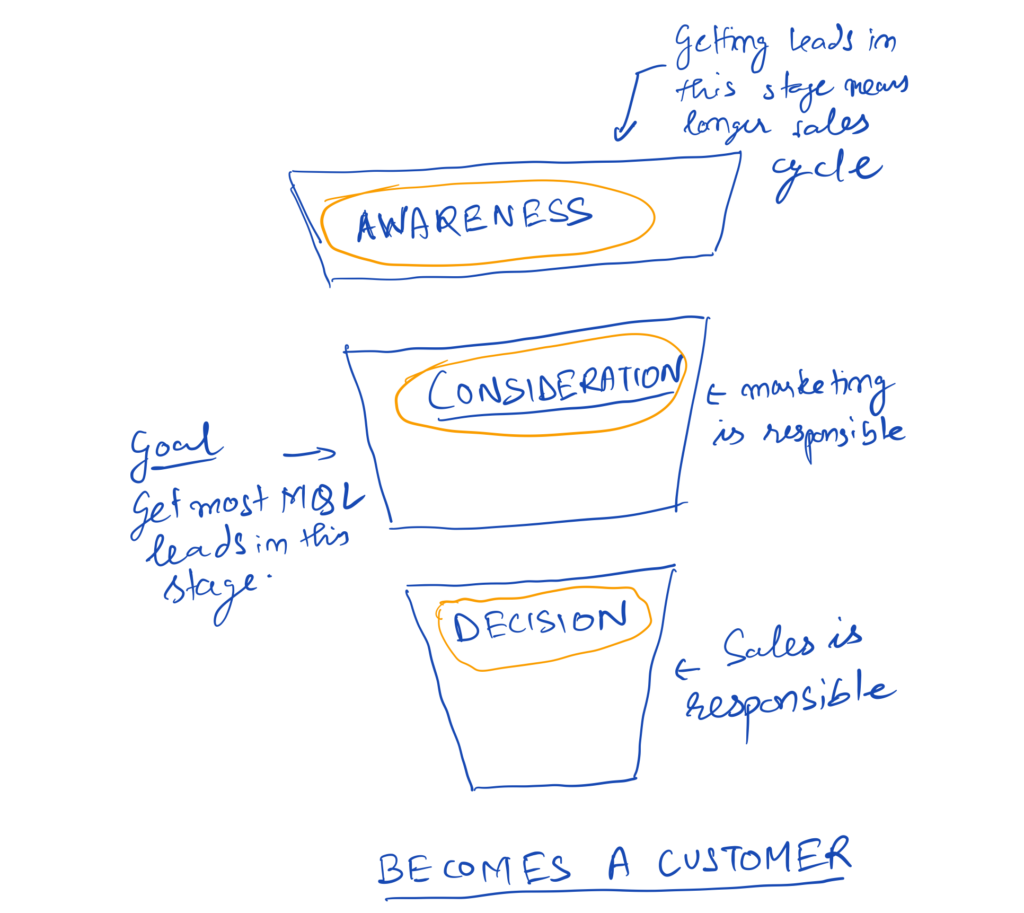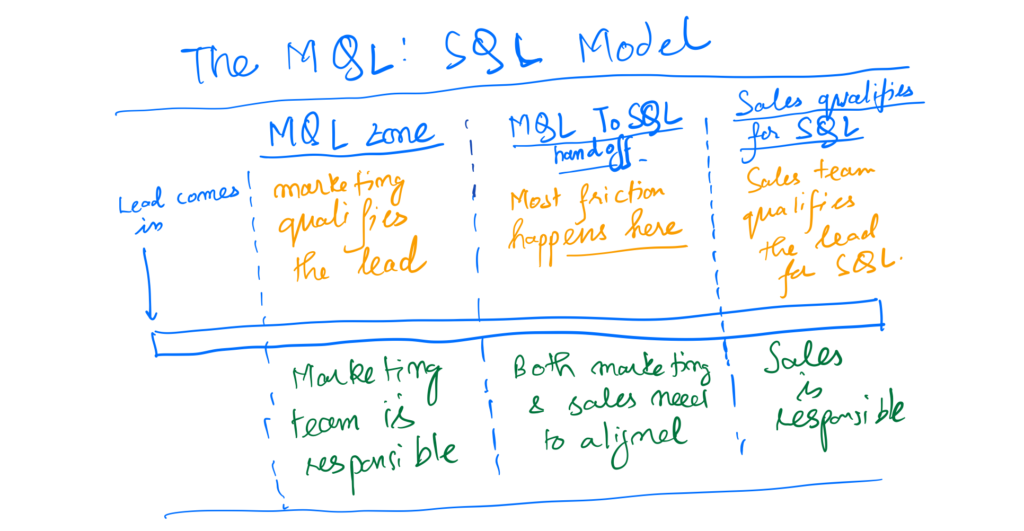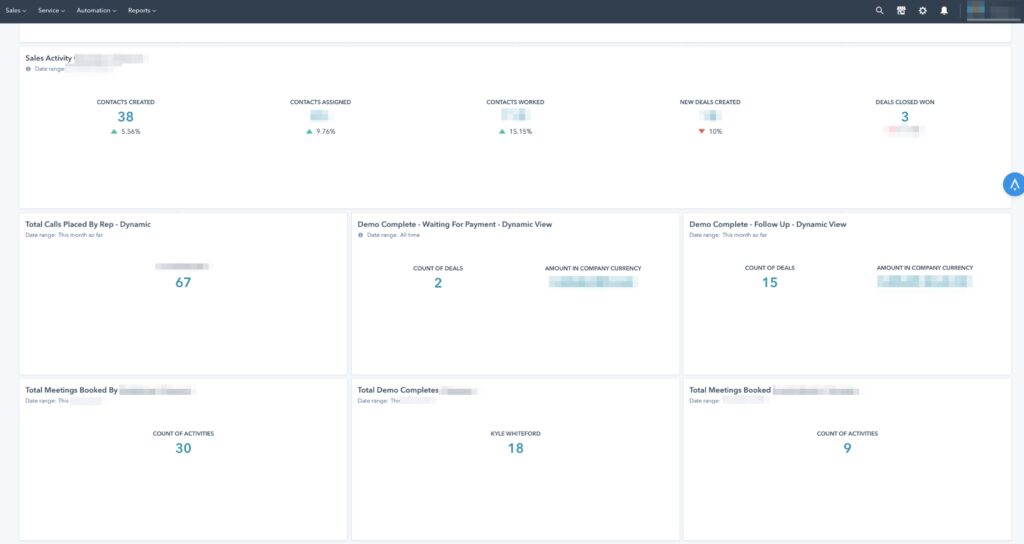
Most companies these days are familiar with the term MQL (marketing qualified lead) and SQL (Sales Qualified Lead). But how effectively, are you using them inside your organization?
In fact, without a clear understanding of what a MQL and SQL is, inside your customer acquisition cycle, you can never scale your revenue.
If you are hearing this for the first time that’s ok. In this blueprint we will cover how to structure and implement a scalable SQL & MQL framework from scratch that your sales & marketing team can be held accountable to.
Let’s begin this guide by defining a few thing and setting some ground rules for creating the ultimate MQL – SQL blueprint for your company.
MQL SQL Ground Rules That We Will Follow
Rule 1: All SQL will be MQL at some point. Not all MQL will be SQL.
Rule 2: Marketing sets the rule for MQL whereas sales team (SDR’s, managers etc.) make the call on which of these marketing qualified leads actually qualify as SQL.
Rule 3: Some MQL might be SQL in the future – meaning that they are not ready yet and needs to be nurtured. This happens a lot for an inbound first approach especially with a longer sales cycle.
Now that we have these 3 ground rules set, we will explore the entire customer acquisition flow to better understand the roles of sales and marketing in closing the deal.
Definition Of A Marketing Qualified Lead (MQL)
Marketing Qualified Lead, MQL is defined as a lead that is generated and qualified by the marketing team of a company based on certain pre-set rules of qualification.
Not all leads generated by a marketing team are qualified. Similarly if you are launch a campaign that is laser focussed on a bunch of big accounts for example through LinkedIN ads then you can expect majority of the leads coming in as MQL.
The first goal to implement a seamless MQL:SQL handoff is to ensure that everyone in your marketing team knows what MQL actually means.
If your startup/company is running a bunch of different funnels targeting prospects in various stages of the buyer journey then you need to have clear MQL definitions for each of those funnels.
For example – a marketing qualified lead for an ebook download funnel might be someone who downloaded the ebook and answered company size as 15 – 50 employees in one of the form fields.
On the other hand, a book a demo funnel can be coupled with additional qualification questions to better qualify the best prospects that fit your persona.
If you are coming across words like personas and buyer journeys for the first time, it’s ok. We will briefly touch upon how buyer personas and lifecycle stage because they both relate closely to outlining prospects as MQL and SQL.
Understanding The Buyer Journey & How It Impacts MQL & SQL Pipelines In Your Company
The buyer journey plays a key role in determining the overall pipeline velocity for your qualified leads.

In short every prospect goes through these following stages before making any purchase:
- Awareness – A prospect becomes aware of their core problem
- Consideration – A prospect starts looking for solutions (this is where marketing comes in to attract leads organically as well as through paid channels).
- Decision – Sales is in control of this stage of the buyer journey. This is when they decide to go with your solution or something else.
Your deal velocity increases significantly if you can get prospects on the later stages of consideration through your marketing. This means that these prospects are aware of a problem and are actively looking for a solution.
If your marketing team solely focuses on getting leads at the awareness stage, the cost per lead might be low, but the sales cycle often involves nurturing these leads to push them through the awareness stage before they are truly sales qualified.
This is an extremely important factor to keep in mind when building out your criteria for a MQL. Make sure that you are considering the buyer journey stage into account.
Building Buyer Personas For Your Product To Better Align Marketing & Sales Qualified Leads
Another key element for creating a marketing and sales qualified lead blueprint is to have a firm understanding of buyer personas.
Work with your sales and marketing team to come up with buyer personas (your ideal customer). Often you will come up with multiple personas which is normal. List all of them down and use that as a guide for creating the rules for sales and marketing qualified leads.
Use this free buyer persona tool created by Hubspot as a guide.
Both your buyer persona and the stage in which a prospect is, in their buying process with act like a compass in determining the overall MQL:SQL framework.
It will ensure that you generate the best possible leads for your company and your sales reps are qualifying the right prospects for them to pitch and close.
Handling Sales Qualified Lead (SQL)
A sales qualified lead is a prospect that has been qualified fit to sell a product or service by someone in the sales team or a process that the sales team follows to qualify every lead that they get.
There are 3 main ways companies and startups qualify a prospect that get as a qualified sales lead (SQL)
#1 Use an SDR to call and qualify
If your marketing team is generating mostly early stage inbound leads (ebook leads, webinar attendees, white paper download leads that asked for a callback etc.), then the best method to qualify those leads is to use an SDR rep or team.
The goal of the SDR team to successfully qualify someone as SQL include:
- Connecting with the lead
- Understanding what stage in the buyer journey are they at
- Asking questions to qualify the prospect and find out if they are a good fit for your product or service.
- If qualified book a time for the demo with one of your actual sales rep. Sometimes when you are just starting out, especially in new startups, reps often work as SDR as well as someone doing the demo alternatively. Just make sure that when sales reps are working as SDR they have a dedicated time block so that you can capture the efficiency of their work in both the roles.
- When you see results from your SDR team, the next stage is to scale it enough so that all of your closers are booked with demos with qualified sales reps.
Important To Remember: The worst mistake a company can make is block general demos with prospects that are never going to buy with your top producers. It’s a recipe for not hitting quota. Use an SDR to pre-qualify and setup demos with leads that are only sales qualified with these top closers in your company.
The SDR strategy is particularly great if you want to improve the demo show up of your SQL prospects.
#2 Analyze A Prospect’s Company To Auto Qualify Without SDR’s
Hiring an SDR sometimes do not make sense when you have a clearly defined audience that you are going after with a mid-priced product (less than $5k). This is because SDR adds to the overall customer acquisition cost and you want that to be low in order to be profitable. Again, I am not saying that is is a golden rule.
You can be an early stage startup investing heavily in market penetration. In that case your CAC can be high. Your focus is growth and not profitability at this point.
Either way, there are ways to do quite a lot of SDR work that involves researching the company to find out if they are a good fit.
With most modern CRM’s you can pull all sorts of information from the email address that comes in as a lead in your marketing funnels. You can group contacts based on companies as well as identify their designation by asking their role within the organization.
The goal with this method is to collect as much information you need in order to gain complete insight on your prospect using your CRM and other tools without involving a manual human being to do the research.
Once marketing starts generating leads that they deem as MQL – this strategy will mostly qualify all of them as SQL because your sales and marketing leaders are working together to ensure that they are going after a selected group of companies or have pre-determined rules on which positions they are looking to pre-qualify as a good lead.
#3 Using Prospect Enthusiasm As a Qualifier (Provided They Know The Cost Of Your Product or Service)
The final method in which a prospect becomes self-qualified involves something that bypasses all of your lead scoring, sales processes for qualification as well as SDR operations.
When a prospect is really excited about a product and wants to use it to help grow their business or get some kind of a result from it.
Usually prospects pre-research your company or they consume lots of content about your organization organically before coming in as a lead. The important thing to understand is that these leads (even if not SQL qualified) should be sent to your main sales guys to pitch and close because they are showing intent.
When a prospect is excited about your service you have the best chance of closing them.
Now that we have a clear understanding of SQL and MQL and how to implement each of them let’s talk about how to setup a seamless system for your organization.
Setting Up a MQL & SQL based system inside your CRM
For this setup, we will be using Hubspot CRM as a model (since we are a Hubspot certified partner) and I personally think it’s one of the best CRM’s out there to clearly define a MQL and SQL based approach while measuring every stage of the prospect’s journey.

Start By Defining Various Dispositions Inside Your CRM
The first stage is to list all of your dispositions inside your CRM. By dispositions I mean, all the lead status or stages that a prospect will go through in order to be marketing qualified and eventually sales qualified.
When you list out all the dispositions you will realize that they fall into these main categories for sales and marketing below.
Marketing Related Disposition Examples:
- New lead – When you get a new lead
- Contact Reconversion – When an old lead comes back again
- Junk – Marketing qualified junk lead (usually a workflow from new leads)
- Demo Booked – If marketing is using a funnel to auto book a demo
- MQL Qualified – A disposition identifying which marketing leads are qualified and ready for the sales team to engage. The MQL Qualified disposition is also when the lead will be transferred to the sales team.
Sales Related Dispositions Example:
Demo No Show – Contact did not show up for a demo that was set with one of your account executives.
Demo Complete – SQL related stages – Once a demo is complete, these dispositions include moving the deal through the various post SQL stages in order to close them.
Closed Won – The disposition we all want to see 🙂
Closed Lost – A deal that is lost for all SQL leads.
A best practice would be to create a journal of all the dispositions and share it with your team. You can also plot your dispositions across the entire customer journey and share the diagram with them for a more visual experience.
Communicating MQL & SQL Handoffs Clearly
Once the dispositions are laid out the next stage is to implement the MQL and SQL standards across sales and marketing. The best way to do this is by calling a meeting of every sales and marketing leader in your company.
In this meeting focus on these main topics:
- Go over the dispositions and how they flow across your organization.
- Communicate and ask questions with your team to find out any overlap issues.
- Clearly communicate the SQL metrics upon which reps will be measured (more on that later in this guide). Do the same for MQL metrics as well. For example, you can give your marketing team a target of generating 500 MQL leads every month using various channels.
Use Our 3 Step System To Determine When A Lead Becomes Sales Qualified:
- Step 1: The lead has to be marketing qualified.
- Step 2: Does the lead fit your buyer persona of an ideal prospect – if yes – then the lead is sales qualified.
- Step 3: If the lead is not qualified – does the lead show proactive enthusiasm and are aware of the price – if yes, then the lead needs to reached out to manually qualify for the sales team. (Usually discovery call).
Build SQL and MQL Related Reports & Dashboards

Now that your team knows how to define a lead as marketing and sales qualified the next step is to create reports and dashboards inside your CRM so that everyone has access to a few key metrics.
If you are using a CRM like Hubspot then you can create multiple reports and add them to one of your custom dashboards. In case you need help setting up these dashboards for your organization feel free to get in touch with me as I have helped several companies create them inside Hubspot.
Anyways, here are some of the metrics that should be tracked in your dashboards
- Total leads generated – total number of leads generated
- Total MQL leads (including % of MQL leads) – Out of all the leads generated how many are MQL leads. This will give you an idea of what percentage are junk and non qualified leads coming from marketing.
- Total Number of SQL (Sales Qualified) Leads
- Percentage of MQL:SQL leads – Total percentage of marketing qualified leads that are also sales qualified.
- Demo Show up Rates on SQL Leads – Total number of prospects that are showing up for demos on your sales qualified leads.
- Cost To Acquire an SQL – Divide marketing ad-spend with total number of sales qualified lead.
- Sales Team Close Ratio on SQL Overall – Close ratio of sales team for sales qualified leads.
- Sales Team Close Ratio on Demo Complete SQL’s – Close ratio of sales team on people that showed up to the demo of your product and are sitting in some kind of a demo complete stage.
MQL & SQL Based Goal Setting For Growth
When the dashboards are complete, you will have a much clearer view of where you need to improve your customer acquisition cycle in order to scale and grow your business.
Building out this MQL and SQL framework allows your sales and marketing team to work together and improve the overall close ratio (I am talking lead to deal ratios).
If you see a particular sales rep with a lower close ratio on demo completes of SQL’s then you would know right of the bat that they need more training on closing.
This MQL-SQL framework also ensures that there are less friction between sales and marketing as the reports will clearly identify how many qualified leads are coming in based on your company’s qualification





0 Comments